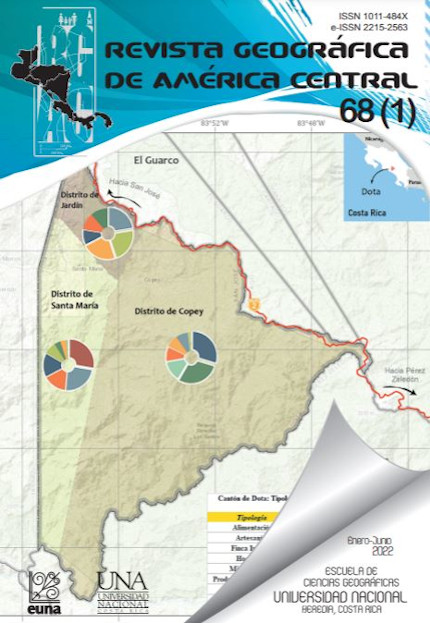Impact on urban form of the new Social Housing projects developed in Costa Rica
DOI:
https://doi.org/10.15359/rgac.68-1.5Keywords:
Residential Complex, Costa Rica, Case studies, Urban Morphology, Social HousingAbstract
In Costa Rica, the social interest housing (VIS) projects developed in the last decade have been located in areas far from urban centers of limited access to facilities and infrastructure due to the prohibitive cost of land ownership in most central sectors of metropolitan cities. The conditions and characteristics of these contexts, available land uses (zoning), morphological configurations, continuity and contiguity between social interest housing projects and the urban pieces where they are inserted, are analyzed in this research through the study of five residential complexes developed in the Greater Metropolitan Area of Costa Rica. The projects, constructed between 2011 and 2018, were analyzed from the study of construction blueprints, cartography of the area, documentary review and analysis of secondary data. From the obtained results it is possible to identify the main difficulties arising from the morphological and typological fit that followed after the establishment of the residential complexes, as well as the contextual problems derived from the location of the projects.
References
Agencia de Ecología Urbana de Barcelona. 2008. «Plan Especial de Indicadores de Sostenibilidad Ambiental de la Actividad Urbanística de Sevilla». Barcelona.
Belén Gobierno Local. (2020). Desarrollo Urbano. Abril 2020, de Municipalidad de Belén Sitio web: https://www.belen.go.cr/web/guest/desarrollo-urbano.
Brenner, N. (2013) Tesis Sobre la Urbanización Planetaria. Revista Nueva Sociedad N°243. Argentina.
Capel, H. (2002). La morfología de las ciudades. Sociedad, cultura y paisaje urbano. Barcelona, Serbal.
Christaller, W. (1933). Die zentralen Orte in Süddeutschland: eine ökonomisch-geographische Untersuchung über die Gesetzmässigkeit der Verbreitung und Entwicklung der Siedlungen mit städtischen Funktionen. University Microfilms.
Colegio Federado de Ingeniero y Arquitectos. (2013). VIII Auditoría de Vivienda de Interés Social. San José, Costa Rica.
Concejo Municipal de Belén (1996). Plan Regulador para el Cantón de Belén. Heredia, Costa Rica.
De la Cal, P. 2018. Las formas del agua en la regeneración urbana de Zaragoza. Recuperación de la red de riego como estrategia de construcción de lugares. Congreso ISUF, Zaragoza, Volumen 3.
FUPROVI (2018) Situación de la Vivienda y Desarrollo Urbano en Costa Rica.
Gehl, J. 2010. Cities for People. Washington: Island Press.
Gómez A., Guillen D. y Salas G. (2018). Morfología, vida urbana y segregación socioespacial: La Carpio, San José, Costa Rica 2017. Revista Geofacies. Costa Rica.
González García, I: “La variedad urbana: Una condición necesaria para la calidad de vida en la ciudad”. Documentación social. Nº 119: Ciudades habitables y solidarias. (2000), pp.115-136.
Hall, C. (1974). La Jerarquía Urbana de Costa Rica: Una Consideración de la Aplicación de Modelos Geográficos. Revista Geográfica De América Central, 1(1), 25-48. Recuperado a partir de https://www.revistas.una.ac.cr/index.php/geografica/article/view/2051
Harvey, D. 2014. Cidades Rebeldes: Do direito a cidade à revolução urbana. David Harvey; tradução Jeferson Camargo. – São Paulo: Martins Fontes – selo Martins.
INEC 2011. Censo de Costa Rica 2011. Recuperado de: Instituto Nacional de Estadísticas y Censos http://www.inec.go.cr/censos/censos-2011.
Laguerre, M. S. (1994). The Informal City. In The Informal City. https://doi.org/10.1007/978-1-349-23540-7_1
López-Goyburu, P. (2012). San Josep, el espacio de borde como articulador entre la ciudad formal y la informal. Periférica Internacional. Revista para el Análisis de la Cultura y el Territorio, (13): 229-240.
Martínez, E. (2003). Necesidades colectivas y desarrollo urbano. La planificación urbana en la perspectiva morfológica de Maurice Halbwachs.
Ministerio de Vivienda y Asentamientos Humanos. (2013). Memoria Institucional 2012-2013. Recuperado el día 29 de marzo de 2020 de https://www.mivah.go.cr/Documentos/transparencia/Despacho/memorias/MEMORIA_2012-2013_MIVAH.pdf
Municipalidad de Desamparados (Sin fecha). Plan de Ordenamiento Territorial del Cantón de Desamparados, San José, Costa Rica.
Quesada, F. (2014). La modernización entre cafetales. San José, Costa Rica, 1880-1930.
Roy, A. (2013) Las Metrópolis del Siglo XXI. Nuevas Geografías de la Teoría. Andamios: Revista de Investigación Social N°22, págs 149-182. México.
Sánchez, A. (2018). Límites Habitables: Estrategia urbano-arquitectónica para la integración socio-espacial, límite quebrada Herrera. Universidad de Costa Rica.
Published
How to Cite
Issue
Section
License
Proposed policy for journals offering Open Access
Authors publishing their works in the Journal acknowledge and agree to the following terms:
a) Authors retain the copyrights to their works and guarantee the Journal the right to be the first to publish their works, under the Creative Commons License Attribution-NonCommercial-ShareAlike 4.0 International, CC BY-NC-SA 4.0 International (https://creativecommons.org/licenses/by-nc-sa/4.0/deed.es), which allows others to share works upon complying with the acknowledgment of authorship and mention of the Journal as the original publisher of the work.
b) Authors are permitted to separately establish additional agreements for the non-exclusive distribution of the official edition of the work published in the Journal (for example, authors may desire to place the work in an institutional repository or incorporate it into a book that is to published elsewhere) so long they acknowledgment to recognize the Journal as the original publisher. The aforementioned additional agreements must respect the terms of the non-profit character and sharing philosophy of the original license (CC BY-NC-SA 4.0 International, https://creativecommons.org/licenses/by-nc-sa/4.0/deed.es).
c) Authors are encouraged to archive the post-print or editor/PDF version in Open Access repositories.






 REVGEO is licensed under https://creativecommons.org/licenses/by-nc-sa/4.0/deed.es
REVGEO is licensed under https://creativecommons.org/licenses/by-nc-sa/4.0/deed.es
.svg_4.png)

_(1).png)
_(1)_(1)_(1)_1.png)
(2)(1)(1)(1).png)
